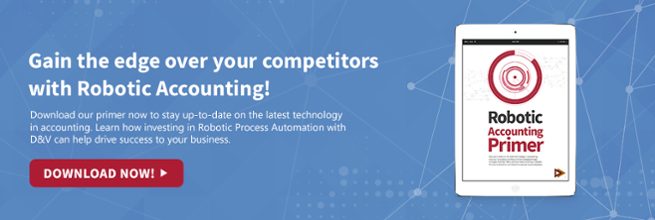Myths & Misconceptions: Robotic Process Automation in Accounting
Robotic process automation in accounting brought drastic changes in the industry. From changing how professionals work to transforming the way we handle government compliance, it is understandable that even professionals and industry leaders develop fears and misconceptions about technological innovation.
.jpg?width=1434&height=600&name=tonik-U0wwiY6nRGA-unsplash%20(1).jpg)
To help you dispel the thoughts that are holding you back from accepting robotic accounting, here are some myths and misconceptions about robotic accounting, and the real facts to address them:
Myth #1: Robotic Accounting will result to the unemployment of finance and accounting professionals
Probably one of the biggest fears of F&A professionals about robotic process automation (RPA) is that it will take their jobs away. Think tanks and industry leaders estimate that close to 70 to 80 percent of finance and accounting services today are going to be automated.
FACT: Robotic accounting helps finance and accounting service providers give better value. With bulk, repetitive and predictable tasks automated, finance and accounting professionals can focus on scaling up their services to provide better insights and value to their clients. Aside from which, robotic accounting also gives faster and more accurate results, thus giving professionals and decision-makers worry-free data sets to use in business analysis.
Myth #2: RPA is 100% fool-proof
Since tasks are going to be automated and done by the platform, we can be sure that it does not have any errors and inconsistencies.
FACT: Robotic accounting is only as accurate as we want it to be. It is crucial to remember that robotic accounting still relies on us to give instructions. It is not a genie that just happens to pop out from a lamp and give us our finance and accounting wishes. During the setup stage, your finance and accounting team will give the platform the appropriate rules to follow in the automation process. The platform will only produce correct results if you have given the correct instructions for it to follow.
Myth #3: It is not wise for us to invest in RPA
The implementation of robotic process automation in accounting will cost us a fortune, and even if we can afford it, it will take us time to recover from our losses.
FACT: You can save a lot of resources with accounting automation. With the chance of getting accurate results now more higher than ever, robotic accounting saves your money and other resources by preventing errors that shouldn’t be there in the first place. More importantly, automating your accounting processes gives you something that money can’t buy such as time to work on things that matter most to you, thus making robotic accounting a worthwhile investment.
Myth #4: My business is currently not ready for RPA
Some business owners are afraid that aside from the cost of setting up robotic process automation, their business size, age or industry won’t benefit from robotic accounting at all.
FACT: Robotic accounting can be applied regardless of size, age, and industry. Robotic accounting is about process improvement, delivering better results by leveraging the available technologies and using them to complement your skills.
RELATED: The Age of Technology: Introducing Robotic Accounting
Overcoming the Challenges of RPA in Accounting
Despite the myths and misconceptions, RPA can be a valuable tool for businesses in the accounting industry. However, there are a number of challenges that businesses need to overcome in order to successfully implement RPA.
One of the biggest challenges is employee resistance.
Some employees may be resistant to change and may fear that RPA will put their jobs at risk. It is important to communicate the benefits of RPA to employees and to train them in how to use RPA systems.
Another challenge is data quality.
RPA systems can only automate tasks that are based on accurate data. If the data is not accurate, the RPA system will not be able to produce accurate results. It is important to have a good data quality program in place before implementing RPA.
Finally, businesses need to be aware of the legal and regulatory implications of RPA.
RPA systems can automate tasks that are currently performed by humans. This means that businesses need to ensure that they are complying with all applicable laws and regulations.
How to choose the right RPA solution for accounting?
With so many RPA solutions on the market, it can be difficult to know which one is right for your business.
Here are some tips on how to choose the right RPA solution for accounting:
1. Consider your specific tasks that need to be automated: You need to identify the specific tasks that need to be automated to choose the right RPA solution.
2. Do your own research. There are many RPA solutions available, so it's important to do your research and consider different factors such as the size and complexity of the business, budget and the level of support that is offered
3. Talk to the right experts. Consult the right experts who can help you choose the right solution for your business.
Without proper knowledge, it is easy to develop fears and misconceptions about groundbreaking innovation and technological breakthroughs. But with the right information and the openness to embrace change, you can take advantage of the future, and use it as an edge over your competition.
Curious about robotic accounting? Talk to our experts today! You can also download our Robotic Accounting Primer and learn more about how you can benefit from robotic process automation in accounting, and how you can prepare your business for its implementation.
This post was first published 10 August 2017 and edited 27 June 2023. Edited by: Angelica Garcia




